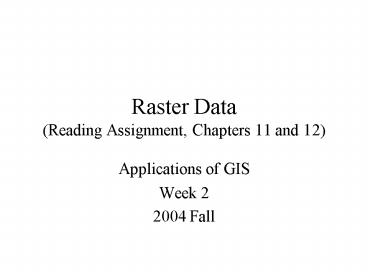Raster Data Reading Assignment, Chapters 11 and 12 PowerPoint PPT Presentation
1 / 8
Title: Raster Data Reading Assignment, Chapters 11 and 12
1
Raster Data(Reading Assignment, Chapters 11 and
12)
- Applications of GIS
- Week 2
- 2004 Fall
2
Elements of the Raster Data Model
- Grid consists of rows, columns and cells.
Origins of rows and columns is at upper-left
corner of the grid. Rows is like y and columns x
coordinates. - Values of cells either integer or
floating-point value. - Resolution 10m, 30m and 90m
3
Types of Raster Data
- Satellite Imagery (landsat7.usgs.gov,
terra.nasa.gov) - DEM (digital elevation models)
- 7.5-minute DEM (30m,10m in UTM) corresponds to a
USGS 124000 scale quadrangle (no-data slivers
box 7.2), Level 1- vertical accuracy of 15m,
Level 2 vertical accuracy of 7 m, derived from
contour lines - LIDAR (light detection and ranging) to produce
detailed DEM - DOQ (Digital Orthophoto quad) from aerial photos.
Mostly 3.75-minute quarter with 1-meter ground
resolution - DRG scanned 7.5-min topo maps with 250 dpi
2.4 meter resolution, georeferenced to the UTM - TIFF, JPEG other image files
4
Data Structure
- Three methods for recoding two-dimensional
regions. - Chain code (figure 7.5)
- Block code (fig 7.6)
- Regional quad (fig 7.7)
5
Data Compression
- MrSID (Multi-resolution Seamless Image Database)
recalling the image data at different
resolutions or scales. Compress a large image
such as a DOQ with subblocks and eliminates the
artificial block boundaries during the
compression process.
6
Georeferening
- Geometric transformation of satellite imagery is
called georeferening - Affine transformation
- through rotation, translation, and scaling
- Polynomial equations
- Requiring selection of control points
- After transformed, a world file is created (such
as tmrect.bil -gt tmrect.biw) - Polynomial equation (is called warping or rubber
sheeting) - A new grid created from polynomial equation.
- Data resampling consists of three methods
(nearest neighbor, bilinear interpolation, and
cubic convolution). - Nearest neighbor is primarily used for
categorical data. However, three methods can be
used for elevation data. Smoothness of the
resampled output increase from nearest neighbor,
bilinear to cubic convolution)
7
Data Conversion - Rasterization and Vectorization
- Rasterization, three steps
- Assign all cells with 0 in coverage area
- Change values of those cells corresponding to
points, lines and polygons. (1 for points, line
value for line and polygons value for a polygon
boundary) - Fill the interior of the polygon outline with the
polygon value
8
Integration of Raster and Vector Data
- DOQs, DRGs and graphics file used for background.
- DEMs can be processed to obtain contour, slope,
aspect, watersheds, shades, stream networks. - DEMs can be converted to TIN (triangulated
irregular network)

